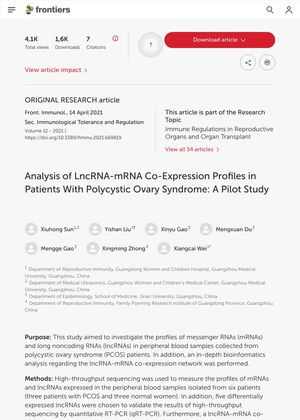Analysis of LncRNA-mRNA Co-Expression Profiles in Patients With Polycystic Ovary Syndrome: A Pilot Study
April 2021
in “
Frontiers in Immunology
”

TLDR Different types of RNAs are found in varying amounts in patients with Polycystic Ovary Syndrome, suggesting they could be important in the disease's development and potentially used as disease markers.
Three pilot studies analyzed the co-expression profiles of long non-coding RNAs (LncRNAs) and mRNAs in patients with Polycystic Ovary Syndrome (PCOS). The first study involved 30 patients and found 1,273 differentially expressed LncRNAs and 1,657 differentially expressed mRNAs. The second study involved six patients and found 14,276 differentially expressed mRNAs and 4,048 differentially expressed lncRNAs. The third study involved 63 patients and found 4,048 differentially expressed lncRNAs and 14,276 differentially expressed mRNAs. All studies found these differentially expressed LncRNAs and mRNAs to be associated with biological processes and pathways, including lipid metabolism, inflammation, and chemokine signaling, which are known to be involved in the pathogenesis of PCOS. This suggests that LncRNAs may play a crucial role in the development of PCOS and could potentially be used as biomarkers for the disease. Further studies are needed to confirm these findings.




